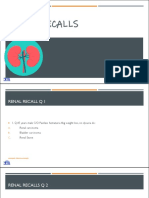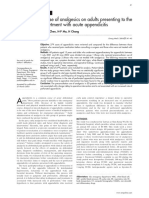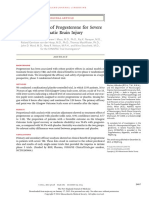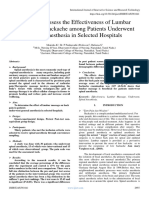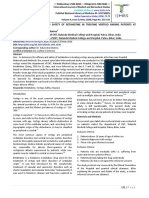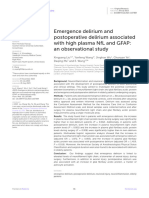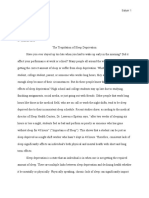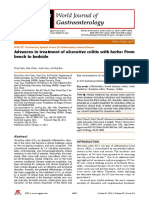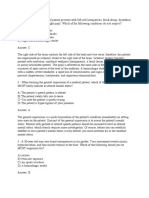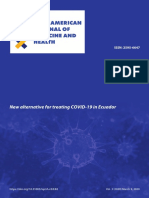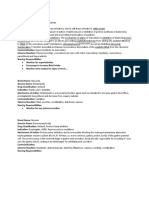Infographics in Anesthesiology: Complex Information For Anesthesiologists Presented Quickly and Clearly
Infographics in Anesthesiology: Complex Information For Anesthesiologists Presented Quickly and Clearly
Uploaded by
Parvathy R NairCopyright:
Available Formats
Infographics in Anesthesiology: Complex Information For Anesthesiologists Presented Quickly and Clearly
Infographics in Anesthesiology: Complex Information For Anesthesiologists Presented Quickly and Clearly
Uploaded by
Parvathy R NairOriginal Description:
Original Title
Copyright
Available Formats
Share this document
Did you find this document useful?
Is this content inappropriate?
Copyright:
Available Formats
Infographics in Anesthesiology: Complex Information For Anesthesiologists Presented Quickly and Clearly
Infographics in Anesthesiology: Complex Information For Anesthesiologists Presented Quickly and Clearly
Uploaded by
Parvathy R NairCopyright:
Available Formats
balt6/z7i-anesth/z7i-anesth/z7i00812/thismonth panickes S 245 6/29/12 22:41 Art: Input-ebh
INFOGRAPHICS IN ANESTHESIOLOGY
Complex Information for Anesthesiologists Presented Quickly and Clearly
THIS MONTH IN
Factors Affecting Admission to Anesthesiology 243
Innate Immune Dysfunction in 411 Residency in the United States: Choosing the Future of
Trauma Patients: From Our Specialty
Pathophysiology to Treatment The proportion of anesthesiology residents from U.S. medical schools has more than dou-
(Clinical Concepts and bled since 1995. This retrospective cohort study evaluated the 2010 and 2011 residency
Commentary) applicants to determine the
Recent insights into posttraumatic immune dysfunction factors associated with a suc-
have defined new targets for immunointervention that cessful admission to resi-
hold promise for improving outcomes in such critically ill dency training programs.
patients.
The sample represented 58%
of the total national applicant
pool; 66% of the applicants
successfully matched to anes-
thesiology. The odds for a suc-
High Intraoperative Inspired 271 cessful match were higher for
applicants from U.S. medical
Oxygen Does Not Increase
schools, those with United
Postoperative Supplemental States Medical Licensing
Oxygen Requirements Examination scores greater
High inspired oxygen may be reasonable in lower risk than 210, younger appli-
surgery to improve wound oxygenation.
cants, and females. Prior
graduate education or peer-
reviewed publications did not offer any advantage. This study suggests the potential for age
and gender bias in the selection process. See the accompanying Editorial View on page 230.
Accuracy of Ultrasound-guided 347 What Factors Affect Intrapartum Maternal Temperature? 302
Nerve Blocks of the Cervical A Prospective Cohort Study: Maternal Intrapartum
Zygapophysial Joints Temperature
Ultrasound imaging was an accurate technique for cervi-
cal zygapophysial joint nerve blocks in volunteers. See the The cause of rises in intrapartum maternal temperature is not known. In this prospective
accompanying Editorial View on page 236. study of 81 women scheduled for labor induction, hourly oral temperatures were recorded
and analyzed based on race, body mass index, duration of labor, and time to epidural.
Overall, temperature rose in a significant linear trend over time. Positive temperature trends
were associated with significantly longer time from membrane rupture to delivery and higher
body mass index. Temperature slopes did not differ before compared with after epidural
analgesia. This study suggests that epidural analgesia alone does not increase the risk of high
Estimation of the Contribution 353 temperatures in intrapartum women.
of Norketamine to Ketamine-
induced Acute Pain Relief and
Neurocognitive Impairment in Postoperative QT Interval Prolongation in Patients 321
Healthy Volunteers Undergoing Noncardiac Surgery under General
Norketamine has an effect opposite to that of ketamine Anesthesia
on pain relief.
Electrocardiograms (ECG) can identify abnormal cardiac repolarization by observation of a
prolonged QT interval. QT interval prolongation is often caused by drugs and can result in
sudden cardiac death. In this ancillary study to the Vitamins in Nitrous Oxide trial, serial
IV = intravenous; NMBAs = neuromuscular blocking agents.
postoperative 12-lead ECG were obtained from 469 patients undergoing major noncardiac
Infographic created by Jonathan P. Wanderer, Vanderbilt University surgeryMedical
underCenter,
generaland James P. Rathmell,
anesthesia. Brighamofand
Eighty percent Women’s
patients Health Care/Harvard
experienced Medical
a significant QT
School. Illustration
Severe Emergence by Annemarie Johnson, Vivo Visuals.
Agitation 399 Address correspondence
interval to Dr.and
prolongation, Wanderer: jonathan.p.wanderer@vanderbilt.edu.
approximately half had increases greater than 440 ms at the end of
after
1. Lee Myringotomy
AI, McCarthy RJ, Toledoin a 3-yr-old
P, Jones surgery.
MJ, White N, Wong CA: Epidural laborOne patient developed
analgesia—fentanyl dose and torsade de pointes.
breastfeeding success:Drugs associated
A randomized withtrial.
controlled prolonged QT
Anesthesiology
2017; 127:614–24 interval included isoflurane, methadone, ketorolac, cefoxitin, zosyn, unasyn, epinephrine,
Child (Case Scenario)
2. Cobb B, Liu R, Valentine E, Onuoha O: Breastfeeding after anesthesia: A review for anesthesia providers regarding the transfer of medications into breast milk. Transl Perioper Pain
Emergence agitation, the associated risk factors, and its ephedrine, and calcium. Although the exact cause of the association between perioperatively
Med 2015; 1:1–7
prevention
3. D and
alal PG, treatment
Bosak areC:discussed.
J, Berlin
administered drugs and QT interval prolongation is not known, further study is warranted to
Safety of the breast-feeding infant after maternal anesthesia. Paediatr Anaesth 2014; 24:359–71
4. Drugs and Lactation Database (LactMed), United States National Library determine the clinical
of Medicine, Nationalrelevance.
Institutes of Health, Department of Health and Human Services. Available at: https://
toxnet.nlm.nih.gov/newtoxnet/lactmed.htm. Accessed August 5, 2017
Anesthesiology, V 127 • No 4 October 2017
Downloaded from anesthesiology.pubs.asahq.org by guest on 02/19/2019
You might also like
- IV Cannulation OET ReadingDocument20 pagesIV Cannulation OET ReadingKush Gurung73% (11)
- Renal MCQ 2021Document27 pagesRenal MCQ 2021Shahriar Ahmed Sujoy100% (2)
- M31 Stress & CopingDocument68 pagesM31 Stress & CopingRNStudent1No ratings yet
- 20221100.0-00007Document3 pages20221100.0-00007Larissa MacielNo ratings yet
- Neu 2021 0177Document9 pagesNeu 2021 0177divinechp07No ratings yet
- AnesthEssaysRes124769-8259973 225639Document5 pagesAnesthEssaysRes124769-8259973 225639Dica ArifiantiNo ratings yet
- Effect Observation of Electro Acupunctute AnesthesiaDocument7 pagesEffect Observation of Electro Acupunctute Anesthesiaadink mochammadNo ratings yet
- Risk Factors of Preoperative Anaesthesia EvaluationDocument2 pagesRisk Factors of Preoperative Anaesthesia EvaluationNur intan cahyaniNo ratings yet
- Jurnal Ficky TriyadiDocument9 pagesJurnal Ficky TriyadiFicky triyadiNo ratings yet
- Annals of Medicine and Surgery: Sintayehu Mulugeta Tamiru, Abere Tilahun BantieDocument7 pagesAnnals of Medicine and Surgery: Sintayehu Mulugeta Tamiru, Abere Tilahun BantieCarlos Gon AlvNo ratings yet
- Maynard 2023Document13 pagesMaynard 2023Ram KNo ratings yet
- Revista 3Document7 pagesRevista 3KeylaOrtizIINo ratings yet
- Jamapediatrics Norman 2017 Oi 170019Document9 pagesJamapediatrics Norman 2017 Oi 170019JORGE ALFREDO BERMÚDEZ NAVANo ratings yet
- Analgesia en Apendicitis AgudaDocument3 pagesAnalgesia en Apendicitis Agudasilvia barbosaNo ratings yet
- 4 SadDocument10 pages4 SadTugberk OrmenNo ratings yet
- Jurnal Reading 5Document10 pagesJurnal Reading 5seewalkNo ratings yet
- Perioperative Medicine: Jean Mantz, M.D., PH.D., EditorDocument3 pagesPerioperative Medicine: Jean Mantz, M.D., PH.D., EditorSf AkhadiyatiNo ratings yet
- Supported By: None.: AbstractsDocument1 pageSupported By: None.: AbstractsFerry DimyatiNo ratings yet
- Strategies of Decresing Anxiety in The Perioperative SettingsDocument16 pagesStrategies of Decresing Anxiety in The Perioperative SettingsFiorel Loves EveryoneNo ratings yet
- Acu Back PelvicPain in Pregnancy RCT 1Document6 pagesAcu Back PelvicPain in Pregnancy RCT 1QuackeryNo ratings yet
- Pan 13575Document2 pagesPan 13575Reynaldi HadiwijayaNo ratings yet
- Noninvasive Neuromodulation in Essential Tremor Demonstrates Relief in A Sham-Controlled Pilot TrialDocument2 pagesNoninvasive Neuromodulation in Essential Tremor Demonstrates Relief in A Sham-Controlled Pilot Trial549142119No ratings yet
- 20.matsota PKDocument19 pages20.matsota PKChristian YonathanNo ratings yet
- Broadbent 2012Document6 pagesBroadbent 2012Czakó KrisztinaNo ratings yet
- Archdischild 2023 326099.fullDocument5 pagesArchdischild 2023 326099.fullAlina1102No ratings yet
- Effect of Anxiolytic Dose On Incidence of Intraoperative Nausea and Vomiting in CS Under Spinal AnesthesiaDocument8 pagesEffect of Anxiolytic Dose On Incidence of Intraoperative Nausea and Vomiting in CS Under Spinal AnesthesiaCentral Asian StudiesNo ratings yet
- Preoperative Identification of Neurosurgery Patients With A High Risk of In-Hospital Complications: A Prospective Cohort of 418 Consecutive Elective Craniotomy PatientsDocument11 pagesPreoperative Identification of Neurosurgery Patients With A High Risk of In-Hospital Complications: A Prospective Cohort of 418 Consecutive Elective Craniotomy PatientsAzizi AlfyanNo ratings yet
- Medicina 59 00823Document13 pagesMedicina 59 00823Ahlam Al ZayatNo ratings yet
- Low Back Pain – Authors' Reply - LancetDocument2 pagesLow Back Pain – Authors' Reply - Lancetanthropo85No ratings yet
- Table of Contents YmemDocument4 pagesTable of Contents YmemahmadrashadshendyNo ratings yet
- Epidural-related-maternal-fever--incidence,-pathopDocument23 pagesEpidural-related-maternal-fever--incidence,-pathopdanawynsze.limNo ratings yet
- Grosse-Sundrup2012 Score PredictifDocument2 pagesGrosse-Sundrup2012 Score PredictifZinar PehlivanNo ratings yet
- Journal Reading SarafDocument10 pagesJournal Reading SarafRifa RoazahNo ratings yet
- Extubation Criteria Following General AnaesthesiaDocument14 pagesExtubation Criteria Following General Anaesthesiamyna.sathu402No ratings yet
- Li 2018Document7 pagesLi 2018Thu TranNo ratings yet
- Jama Blakely 2024 Oi 240020 1710443209.74411Document10 pagesJama Blakely 2024 Oi 240020 1710443209.74411rdh19478No ratings yet
- Time Is Spine': New Evidence Supports Decompression Within 24 H For Acute Spinal Cord InjuryDocument2 pagesTime Is Spine': New Evidence Supports Decompression Within 24 H For Acute Spinal Cord InjuryJUAN GUAPO MENDOZANo ratings yet
- Shoulder Tip Pain After Cesarean Section General.14Document5 pagesShoulder Tip Pain After Cesarean Section General.14King BentoNo ratings yet
- Hirano 1999Document7 pagesHirano 1999LitaDwiNo ratings yet
- 1 s2.0 S2005290116300255 MainDocument8 pages1 s2.0 S2005290116300255 MainNurul AzizahNo ratings yet
- Intramuscular Versus Intravenous Therapy For PrehospitalDocument10 pagesIntramuscular Versus Intravenous Therapy For PrehospitalAbdullah ShiddiqNo ratings yet
- 1 s2.0 S0007091220303391 MainDocument9 pages1 s2.0 S0007091220303391 MainAfniNo ratings yet
- Apnea After Awake Regional and General Anesthesia in InfantsDocument17 pagesApnea After Awake Regional and General Anesthesia in InfantsmluthfidunandNo ratings yet
- Pain Practice - 2023 - Gish - Neuromodulation For The Management of Chronic Pelvic Pain Syndromes A Systematic ReviewDocument20 pagesPain Practice - 2023 - Gish - Neuromodulation For The Management of Chronic Pelvic Pain Syndromes A Systematic ReviewfernandomurcianoNo ratings yet
- A Study To Assess The Effectiveness of Lumbar Massage On Backache Among Patients Underwent Spinal Anesthesia in Selected HospitalsDocument6 pagesA Study To Assess The Effectiveness of Lumbar Massage On Backache Among Patients Underwent Spinal Anesthesia in Selected HospitalsInternational Journal of Innovative Science and Research TechnologyNo ratings yet
- Chi Kun GunyaDocument1 pageChi Kun GunyayodhaarspinoNo ratings yet
- Bmjopen 2020 042510Document12 pagesBmjopen 2020 042510Lettisia AnggraNo ratings yet
- Stress Periop MecDocument6 pagesStress Periop MecAnca OuatuNo ratings yet
- Multiple Choice Questions in Medical Schools: Saudi Medical Journal December 2000Document10 pagesMultiple Choice Questions in Medical Schools: Saudi Medical Journal December 2000RAJESH SHARMANo ratings yet
- Inflammation - Friend or FoeDocument2 pagesInflammation - Friend or Foeandrzej.daszkiewicz832No ratings yet
- Abstracts of The 2018 AANS/CNS Joint Section On Disorders of The Spine and Peripheral Nerves Annual MeetingDocument109 pagesAbstracts of The 2018 AANS/CNS Joint Section On Disorders of The Spine and Peripheral Nerves Annual MeetingEka Wahyu HerdiyantiNo ratings yet
- Obstetric Neurological Injuries: ReviewDocument8 pagesObstetric Neurological Injuries: Reviewaish25No ratings yet
- Shortal2019 PDFDocument13 pagesShortal2019 PDFdr_imronrosyadiNo ratings yet
- Agitasi Pada Kelompok Dewasa Setelah Anestesi UmumDocument10 pagesAgitasi Pada Kelompok Dewasa Setelah Anestesi UmumUzZySusFabregasNo ratings yet
- 1238-Article Text-1741-1-10-20200626Document3 pages1238-Article Text-1741-1-10-20200626neurologie blokNo ratings yet
- PIIS1089947220302409Document6 pagesPIIS1089947220302409Mbah AbuNo ratings yet
- Peripheral Nerve Stimulation For Painful Mononeuropathy Secondary To Leprosy: A 12-Month Follow-Up StudyDocument6 pagesPeripheral Nerve Stimulation For Painful Mononeuropathy Secondary To Leprosy: A 12-Month Follow-Up StudySartika Ayu NingsihNo ratings yet
- 2016 Parasternal, Pecto-Intercostal, Pecs, and Transverse Thoracic Muscle Plane Blocks A Rose by Any Other Name Would Smell As SweetDocument2 pages2016 Parasternal, Pecto-Intercostal, Pecs, and Transverse Thoracic Muscle Plane Blocks A Rose by Any Other Name Would Smell As SweetDaniela Alejandra Bravo RomeroNo ratings yet
- Emergency DeleriumDocument10 pagesEmergency DeleriumСарангэрэл ГалбадрахNo ratings yet
- Carpal Tunnel SyndromeDocument6 pagesCarpal Tunnel Syndromeresidents 2020No ratings yet
- 【2019】Enhanced Peri-Operative Care for High-risk patients (EPOCH) triaDocument6 pages【2019】Enhanced Peri-Operative Care for High-risk patients (EPOCH) triacharmyshkuNo ratings yet
- BJAEd - Analgesia For Caesarean SectionDocument7 pagesBJAEd - Analgesia For Caesarean SectionDragos IonixNo ratings yet
- Peripheral Receptor Targets for Analgesia: Novel Approaches to Pain ManagementFrom EverandPeripheral Receptor Targets for Analgesia: Novel Approaches to Pain ManagementNo ratings yet
- 288 Paediatric Anaesthetic Emergencies Part 2 (1) - 0Document6 pages288 Paediatric Anaesthetic Emergencies Part 2 (1) - 0Parvathy R NairNo ratings yet
- 265 Coarctation of The AortaDocument11 pages265 Coarctation of The AortaParvathy R NairNo ratings yet
- 97 Anaesthesia For LSCS Part 3 General AnaesthesiaDocument9 pages97 Anaesthesia For LSCS Part 3 General AnaesthesiaParvathy R NairNo ratings yet
- 70 Neonatal Anaesthesia 2 Anaesthesia For Neonates With Abdominal Wall DefectsDocument10 pages70 Neonatal Anaesthesia 2 Anaesthesia For Neonates With Abdominal Wall DefectsParvathy R NairNo ratings yet
- 41 Management of Obstetric HaemorrhageDocument5 pages41 Management of Obstetric HaemorrhageParvathy R NairNo ratings yet
- 31 Coagulation Disorders in PregnancyDocument12 pages31 Coagulation Disorders in PregnancyParvathy R NairNo ratings yet
- 18 Paediatric Regional Block GuidelinesDocument10 pages18 Paediatric Regional Block GuidelinesParvathy R NairNo ratings yet
- Lung CA HandoutDocument8 pagesLung CA HandoutEnzo TimbolNo ratings yet
- Current Knowledge of Schisandra ChinensisDocument24 pagesCurrent Knowledge of Schisandra ChinensisrapipenNo ratings yet
- Calcium Gluconate 10% Emergency MedicationDocument2 pagesCalcium Gluconate 10% Emergency MedicationRafiq Esufzae0% (1)
- Rough Draft Research Paper 11Document14 pagesRough Draft Research Paper 11api-549217680No ratings yet
- Doproct Suppository & Doproct Rectal Ointment: Jauhi Daripada Kanak-KanakDocument1 pageDoproct Suppository & Doproct Rectal Ointment: Jauhi Daripada Kanak-KanakKhin Zaw HtweNo ratings yet
- List Obat Obatan LCT PERINTIS UTAMADocument3 pagesList Obat Obatan LCT PERINTIS UTAMANers SultanNo ratings yet
- Advances in Treatment of Ulcerative Colitis With HerbsDocument7 pagesAdvances in Treatment of Ulcerative Colitis With HerbsJoão CarlosNo ratings yet
- Gebecip 500mg Tablets (Ciprofloxacin)Document7 pagesGebecip 500mg Tablets (Ciprofloxacin)niikwabena36No ratings yet
- Bromelaina PDFDocument9 pagesBromelaina PDFMarco Antonio García LunaNo ratings yet
- AEMT - Medical Exam PracticeDocument26 pagesAEMT - Medical Exam PracticeEMS DirectorNo ratings yet
- AST and Dosing Info Card - FINALDocument2 pagesAST and Dosing Info Card - FINALGAYATHIRINo ratings yet
- Natural Products: Presented By: Jennifer G. ValdezDocument61 pagesNatural Products: Presented By: Jennifer G. ValdezJennifer ValdezNo ratings yet
- Microbiology Infection Disease - Urinary InfectionDocument13 pagesMicrobiology Infection Disease - Urinary InfectionVINCENT CHANDRA KUSUMANo ratings yet
- Lplpo Pustu 2020Document21 pagesLplpo Pustu 2020Andi FatmasariNo ratings yet
- CHECKLIST - Administering Oral, Sublingual, and Buccal MedicationDocument4 pagesCHECKLIST - Administering Oral, Sublingual, and Buccal MedicationMichael100% (1)
- Increased Intracranial PressureDocument48 pagesIncreased Intracranial PressureJulia Rae Delos SantosNo ratings yet
- 2020 Complete Drug List FormularyDocument204 pages2020 Complete Drug List FormularyYvetal GardeNo ratings yet
- Sympathomimetic Agents A4Document8 pagesSympathomimetic Agents A4naveenvau1988No ratings yet
- 2016 Esc Guidelines For The Diagnosis and Treatment of Acute and 2016Document85 pages2016 Esc Guidelines For The Diagnosis and Treatment of Acute and 2016aslinNo ratings yet
- Drug Study HemoDocument5 pagesDrug Study HemobarugacristianNo ratings yet
- Viusid Alternative Treatment Covid19Document7 pagesViusid Alternative Treatment Covid19Putri RahmiNo ratings yet
- N-Acetylcysteine: Reversal Agent/Antidote Toxicant/Main Indications CommentsDocument3 pagesN-Acetylcysteine: Reversal Agent/Antidote Toxicant/Main Indications CommentsAshner ShatovNo ratings yet
- Supplements UPDATED - OCT 2023Document9 pagesSupplements UPDATED - OCT 2023r_sendhilNo ratings yet
- 2.3 Sulfated Ash Final Text For Revision of The International PharmacopoeiaDocument2 pages2.3 Sulfated Ash Final Text For Revision of The International PharmacopoeiaBambangNo ratings yet
- LabanLEGALIZE MEDICAL MARIJUANADocument13 pagesLabanLEGALIZE MEDICAL MARIJUANAArnold SumadilaNo ratings yet
- Drug StudyDocument2 pagesDrug StudymatthewchadNo ratings yet
- Fogsi Position Statement On The Use of ProgestogensDocument9 pagesFogsi Position Statement On The Use of ProgestogensRaviraj TirukeNo ratings yet

